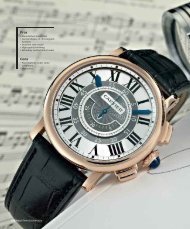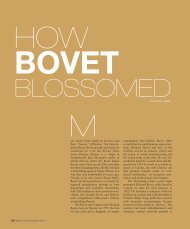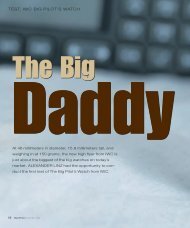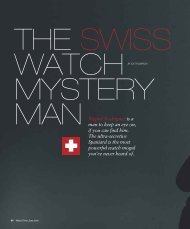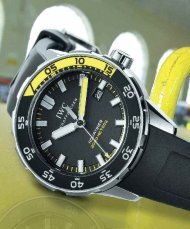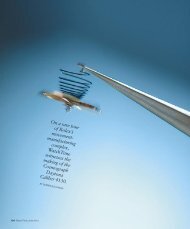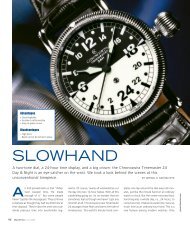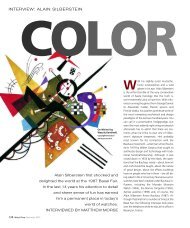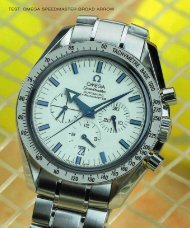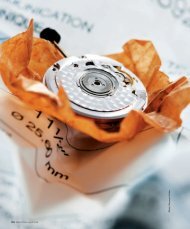WT_2006_05: TEST: TAG HEUER CARRERA CALIBRE 360
WT_2006_05: TEST: TAG HEUER CARRERA CALIBRE 360
WT_2006_05: TEST: TAG HEUER CARRERA CALIBRE 360
- No tags were found...
Create successful ePaper yourself
Turn your PDF publications into a flip-book with our unique Google optimized e-Paper software.
<strong>TEST</strong>: <strong>TAG</strong> <strong>HEUER</strong> <strong>CARRERA</strong> <strong>CALIBRE</strong> <strong>360</strong>118 WatchTime October <strong>2006</strong>
The 100-per-Second Solution<strong>TAG</strong> Heuer has developed the fastest – and most precise –mechanical wristwatch chronograph ever, able to measuretime to the nearest 100th of a second. We put this muchanticipatedtimepiece through its paces.BY JENS KOCHPhotos by imaginaAdvantages+ Extremely accurate stop-timefunction+ Very good rate resultsDisadvantages– The time is not perfectly legibleDecember 20<strong>05</strong> WatchTime 119
Only the ETA 2892 is visible through the window in the back ; the chronograph module is concealed on the dial side of the base movement.Of all the attributes a connoisseur looksfor in a wristwatch, speed is generallynot at the top of the list. Whowants a watch that runs too fast rather thanwith smooth, controlled precision? However,increased precision in a watch is often theresult of increased speed in the movement’sbalance.This is particularly significant in a wristwatchchronograph, a watch with a built-instopwatch function to measure the durationof elapsed intervals. Long-term precision, ordeviation in seconds per day, is less importanthere than short-term precision, or the abilityto measure fractions of seconds. The handsneedn’t run faster to accomplish this, but thebalance — the “heart” of every mechanicalwatch — must beat faster.The seconds hand of a modern mechanicalwristwatch typically advances througheight increments every second. This is also thenumber of times the watch ticks per secondbecause the pallets release the escape-wheelonce for each vibration of the balance. Eachrelease allows the next tooth of the wheel tostrike against one or the other of the two pallet-stones.The seconds hand of the fastestwell-known movement, Zenith’s El Primero,advances only 10 times per second.<strong>TAG</strong> Heuer created a stir at this year’s Baselwatch fair with the unveiling of a new watchwith a balance frequency that is fully 10 timesfaster than the El Primero. The Carrera Calibre<strong>360</strong> measures intervals to the nearest100th of a second, meaning the chronograph’sseconds hand must advance through100 increments every second. Constructingsuch a lightning-fast oscillator poses severalproblems. It’s no coincidence that most manufacturershave settled on making movementswith balances that oscillate at a frequencyof eight vibrations per second, or28,800 vibrations per hour. The leisurely paceof five beats per second (the standard forpocket watches) was adjusted up for wristwatches,which are more commonly exposedto external motions and shocks, first to six,and eventually to eight beats per second. Thisreduced their vulnerability to impacts andmade it possible to rely on balances withsmaller diameters. But increasing a balance’sfrequency beyond these parameters invariablycreated problems with friction and theretention of lubricant oil.The Carrera Calibre <strong>360</strong> performed well in our wrist tests, with a daily loss of about two seconds.It would have been close to perfect if the two seconds were gained instead of lost.120 WatchTime October <strong>2006</strong>
<strong>TEST</strong>: <strong>TAG</strong> <strong>HEUER</strong> <strong>CARRERA</strong> <strong>CALIBRE</strong> <strong>360</strong>When Microtimer appeared in 2002, it wasthe first Swiss wristwatch with 1,000th-of-asecondprecision. The company kept andkeeps time at many ski races, rallies and carraces. The brand made an especially goodname for itself as official timekeeper for theFormula One and the Ferrari racing team.<strong>TAG</strong> Heuer is currently official timekeeper forthe Mercedes-McLaren Formula One teamand the Indy 500 racing series. In professionalsports time measurement, <strong>TAG</strong> Heuer hasthe ability to measure intervals to the nearest100,000th of a second. So what would be amore natural step than to push the envelopewith a mechanical wristwatch chronograph?<strong>TAG</strong> Heuer designates as Calibre 36 watchesthat encase the 36,000-vph chronographCaliber El Primero, which is supplied by Zenith,<strong>TAG</strong> Heuer’s sister company in the LVMHGroup. A movement with a balance that oscillatesten times as fast is logically designated asCalibre <strong>360</strong>. <strong>TAG</strong> Heuer’s successful Carreraseries takes its name from the legendary raceknown as the Carrera Panamericana Mexico.Despite the complexity of its separate geartrains, the Carrera Calibre <strong>360</strong> doesn’t look sounusual at first glance. The dial displays thehours and minutes from the center, keepstrack of the seconds on a subdial at the 3, andshows the chronograph’s functions as follows:a centrally axial elapsed seconds hand, a30-minute counter at the 9 and a highlightedsubdial for fractions of seconds at the 6. Thechronograph’s remaining power reserve is displayedon the upper part of the dial. A datewindow is located between the 4 and the 5.Instead of hour indices, the main dial is calibratedwith a dozen numbers, each five digitsapart, to facilitate reading the minutes andseconds from zero to 60.The moment the chronograph is switchedon, its ultra-speedy balance begins to oscillateand the 100ths-of-a-second hand starts to flyaround its large subdial, speeding through100 increments to complete one circumnavigationevery second. Because the chronograph’scentrally axial elapsed-seconds handsis likewise powered by the 100ths-of-a-secondwheel via a step-down differential, it tooadvances through not eight but 100 incrementseach second, which a human eye perceivesas a fluent motion. The interstitialstrokes could have been left out on the secondsscale around the main dial’s peripherybecause fractions of seconds are already indicatedaround the periphery of the large subdi-Layer upon layer (above): an exploded view of themodular architecture of the Calibre <strong>360</strong>. Right: thechronograph’s balance is 26% smaller than the ordinarybalance and oscillates 12.5 times more frequently.124 WatchTime October <strong>2006</strong>
Speed trip: the instant the chronograph is switched on, the 100ths-of-a-second hand flies around the subdial at a breakneck pace.al at the 6. As fascinating as the sight of thegliding elapsed-seconds hand is the soundmade by the escapement: its ticks and tockssucceed one another so rapidly that their individualsounds blend into a steady hum.Quicker Than the Human EyeTechnical achievement and innovation are thiswatch’s special features, but we can’t helpwonder whether a human being, endowedwith a mere mortal’s sluggish reaction time, iscapable of measuring time with the accuracyprovided by this chronograph. To answer thisquestion, <strong>TAG</strong> Heuer invited journalists to testthe watch. The participating reporters clockedFerrari and Mercedes-McLaren Formula Onevehicles at the Formula One training track in LeCastellet, France. Reference time was providedby visual timekeeping of lap times to thenearest 1,000th of a second. On the average,the lap times clocked by hand with the CarreraCalibre <strong>360</strong> were within four or five 100ths ofa second of official time. So despite the slowhuman reaction times, <strong>TAG</strong> Heuer’s wristwatchchronograph measured elapsed times significantlymore accurately than the previousrecord holder, Zenith’s El Primero, which is accurateto “only” the nearest tenth of a second.Hand-held timekeeping can still achieveeven better results, however, as was shown bycomparison with an electronic hand-heldstopwatch. Here, the measured values werean additional 2/100ths of a second closer toreality. The reason: in addition to the lag dueto human sluggishness, the mechanical operationof the button and the mechanism it triggersalso requires a fleeting interval of time.The electronic watch enjoys a clear advantagehere. But the Carrera too could be improvedto reduce this difference. There’s not muchthat can be done about the resistance offeredby the push-pieces, although <strong>TAG</strong> Heuer hasgiven the start/stop button a large upper surface,which distributes a fingertip’s pressureand thus enhances ease of operation.Nonetheless, the push-piece must first descenda short way before it reaches the pointwhere it acts on its mechanism, and this ineffectualthrow no doubt adds one or two100ths of a second to the delay. PerhapsThe elapsed-seconds hand advances 100 times every second. The ticks and tocks come sorapidly that their individual sounds blend into a steady hum.126 WatchTime October <strong>2006</strong>
The Calibre <strong>360</strong>’s chronograph movement has a 100-hour power reserve, as seen on the fan-shaped indicator on the dial.Porsche might serve as a model for <strong>TAG</strong> Heuerto emulate in improving this detail: in returnfor a surcharge, the sportscar manufactureroffers the option of reduced shift throw.The return-to-zero button requires significantlymore force than the start/stop button.Except for this minor complaint, the back-tothe-beginningbutton functions perfectly. Aswith the basic Caliber ETA 2892, a large andeasily grasped crown allows the user to operatethis watch’s functions in the customarymanner. The fully extracted crown halts thebalance (and with it, the continuously runningseconds-hand) so the seconds-hand can besynchronized with a radio time signal. In itsfirst extracted position, the crown can bewound to rapidly advance the date display.There is, however, a difference in the crown’sinmost position: turning the crown clockwisewinds the mainspring of the timekeeping motion-train;turning it counterclockwise windsthe mainspring that powers the chronograph.Counterclockwise rotation of the crown inits innermost position also causes the hand onthe chronograph’s power-reserve display tomove toward the 100 on its scale. This meansthat the chronograph’s barrel has amassedenough power to continue to run for approximately100 minutes. If the spring inside thisbarrel has been fully wound before the stopwatchfunction is switched on, the power-reservedisplay will enable you to measure intervalsbeyond the capacity of the 30-minutecounter alone. In fact, you can clock intervalsup to three hours and 10 minutes long.Unlike the relatively low contrast betweenthe pale dial and the skeletonized silver hourhandand minute-hand, the chrono hand isvery easy to read. The red tip on the 100ths-ofa-secondhand is instantly visible above its bluesubdial, although the strokes on the scale areunavoidably quite slender.Movement Times TwoThe most innovative aspect of the CarreraCalibre <strong>360</strong> is its movement. The base CaliberETA 2893 has been modified so that it can beaugmented with the chronograph module,which includes its own mainspring and escapementgroup — in effect, two separatemovements. The winding mechanism hasbeen altered so that it can also wind the chronograph’sbarrel. The date display, whichwould otherwise have nearly vanished intothe depths of the module, has been movedup. All in all, the movement contains morethan 230 components, of which 131 belongto the chronograph module. For the chronograph’sbalance to achieve <strong>360</strong>,000 vibrationsper hour, its balance spring had to be very tinyand the balance had to be both lighter inweight and 26% smaller than an ordinarybalance. <strong>TAG</strong> Heuer relies on a hard lubricantto solve the problem of keeping oil in its properplace at such high speeds and under the influenceof such strong forces.The chronograph is controlled by a hybridconsisting of a column-wheel and a cam. Thestart/stop button moves a column-wheelwhich serves only to block the return-to-zerolever when the chronograph is switched on.128 WatchTime October <strong>2006</strong>
<strong>TEST</strong> RESULTS<strong>TAG</strong> <strong>HEUER</strong> <strong>CARRERA</strong> <strong>CALIBRE</strong> <strong>360</strong>Strap and clasp: (max. 10 points): The handsewncrocodile-skin strap and the white-goldpronged buckle are beautifully crafted. 9Operation (5): All time functions, includingthe rapid resetting of the date display and thestop-seconds function, are controlled via thecrown. The chronograph’s mainspring is likewisewound via the crown. The return-to-zerobutton could offer less resistance. 4Case (10): Good craftsmanship and beautifuldetails, including the large start/stop buttons,the grooves in the crown and push-pieces, andthe inwardly sloping horns. 8Design (15): The design is successful. The applied,domed digits for the seconds and minutes(0 to 60) make it abundantly clear that thistimepiece is also a stopwatch. 12Legibility (5): Silver hands on a pale dial don’tcreate a high contrast. Small, luminous trianglesimprove legibility in the dark. The skeletonizedhands improve the legibility of stopped intervals.The subdial for 100ths of seconds is largeenough. 4Wearing comfort (10): The supple strap andthe smooth back of the case both fit comfortablyagainst the wrist. But the heavy weight ofthe white-gold watch makes it feel somewhattop-heavy. 9Movement (20): The movement is based onthe ETA 2892, which powers three hands and adate display. The chronograph function isadded as a module. This results in the only mechanicalwristwatch chronograph that can preciselystop intervals to the nearest 100th of asecond, as well as the only such wristwatchwith a second balance and a second escapement.Decorations and fine processing were nota high priority. 18Rate results (10): As the chronometer certificateindicates, the greatest deviation amongthe several positions was pleasantly low. Thevery stable amplitude was also convincing, butthe movement could have been adjusted togain slightly more. 9Overall value (15): The extra charge for thegold case remains within the usual ballpark. Thequality is good and the price is appropriate forsuch an elaborate and innovative complication.This brand, however, has not previously beenknown for watches in this price category. 12TOTAL:85 pointsThis button also acts via a lever to release thebalance; pressing the same button a secondtime halts the balance. In an ordinary chronograph,the elapsed-interval counters are alternatelyengaged with and disengaged fromthe continuously running movement; here,however, the chronograph movement, includingits barrel, balance and escapement,is started by releasing the balance andstopped by halting it.Comfortable fit: white-gold pronged buckle and blue crocodile-skin strapReturn to zero is triggered by a second button,which acts via the return-to-zero lever tomove the return-to-zero hearts of the threecounters back to their starting positions andthus reset the hands to zero. As is common in amodular chronograph, here too the return-tozerohearts are firmly affixed to each hand’sshaft, while the gears are only friction-fit. Thisallows the hands to be reset to zero withoutcausing the gears to move. A complex uncouplingfor the individual counters is therefore notnecessary during the return-to-zero process.Power through two separate movements hasanother advantage: the chronograph doesn’t adverselyaffect the accuracy of the ordinary timedisplay because the stopwatch is powered by itsown barrel and therefore saps no energy fromthe motion-train. Starting the chronographmechanism ordinarily causes a sudden decline inthe balance’s amplitude, which can interfere withthe regularity of the rate. But the only points ofcontact between the motion-train and the chronographmovement in Calibre <strong>360</strong> are the windingmechanism (both barrels are wound by thecrown) and the shaft of the elapsed-secondshand, which runs through the hollow pipe thatbears the minute-hand. Hence, switching on thechronograph cannot negatively affect the motion-train.Furthermore, the movement hasearned an official chronometer certificate fromthe unbiased inspectors at the COSC.Our high expectations were confirmed onthe timing machine, which showed that thegreatest deviation among the several positionswas an impressively low value of justfour seconds. Average deviation was a scantdaily loss of just 1.3 seconds. The watchrecorded a daily loss of about two seconds inour wrist test: that’s good performance, and itwould have been close to perfect if the twoseconds were gained rather than lost. Wewere also impressed by the high amplitudeand the very slight amplitude decline whenthe hanging positions are compared with theflat orientations.So add a very accurate rate to this watch’svirtues of high-quality craftsmanship, successfuldesign, and above all an extraordinarilyinnovative movement. Considering allthese fine qualities, the price of the whitegold version ($16,000) that we tested seemsreasonable. The steel version is even morehighly recommended: manufactured in a limitededition of <strong>360</strong>, it provides better legibilityfor the time of day and costs just $7,500. Theretail price is appropriate, even if some customersmight wonder about it because <strong>TAG</strong>Heuer is not known for watches in this priceclass. The mere knowledge that one is wearingthe world’s fastest mechanical wristwatchchronograph is enough to make many watchlovers’ hearts beat faster.■130 WatchTime October <strong>2006</strong>



